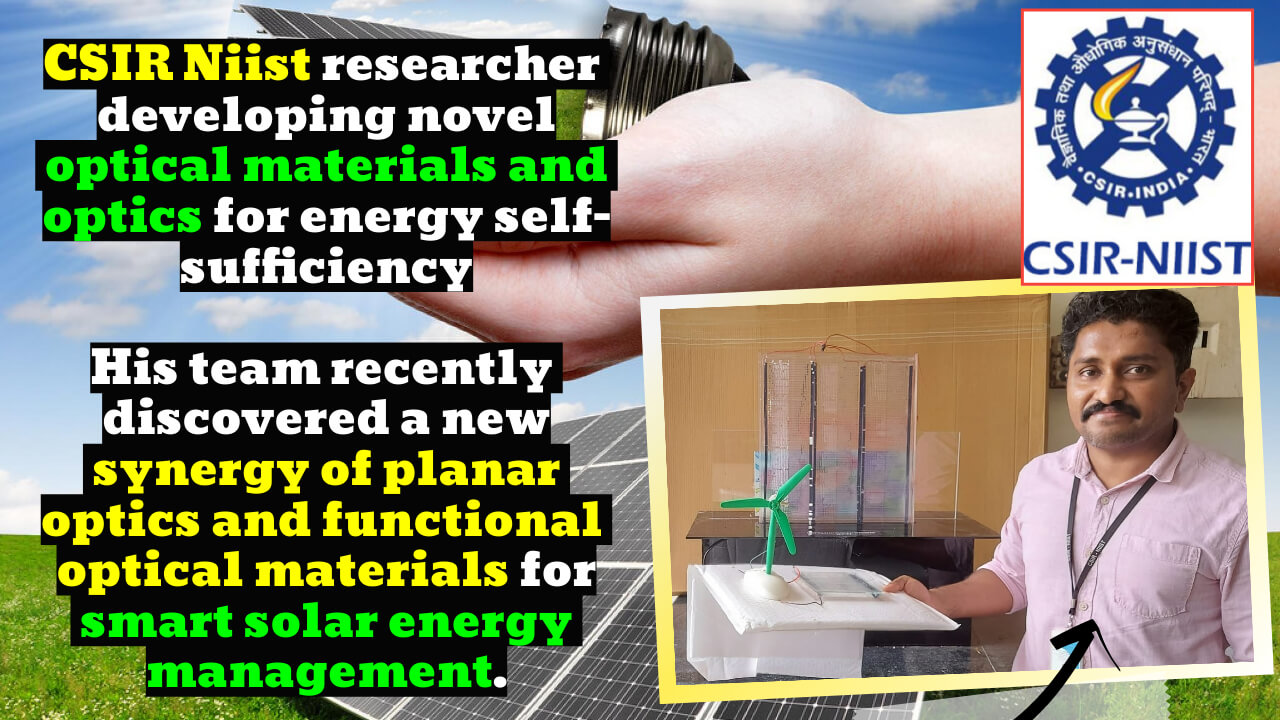CSIR-NIIST has found that planar optics and functional optical materials work together uniquely. This can help meet the needs that haven’t been met in the energy, environment, and healthcare fields. Dynamic Power Windows is a new technology that lets you change the level of transparency (solar heat gain control).
Key Highlight:
- The solar optics and materials development group led by Dr. Adersh Asok, a DST-INSPIRE Faculty fellow, has worked at CSIR-NIIST for 5 years.
- Dr. Asok and his team have discovered a novel synergy of planar optics and functional optical materials for smart solar energy management.
- His technologies include Dynamic Power Windows, which combines adaptive transparency (solar heat gain control) and clean electricity generation.
- Planar light concentrators and diffusers offer game-changing solar light management technologies for BIPV/T and Agrivoltaics.
- His research on novel optical materials and optics for DPW, BIPV/T, and Agrivoltaics, coupled with his R&D group, can help advance energy self-sufficiency.
The group led by Dr. Adersh Asok, a DST-INSPIRE Faculty Fellow, has been working on solar optics and materials development at CSIR-NIIST for the last five years. This group has helped with the development of both experimental and computational optics.
Focusing on optical materials and optical engineering for smart solar energy management, Dr. Asok’s group found that planar optics and functional optical materials can work together uniquely to make solar energy more efficient. The study was published in the journal ACS Appl. Nano Mater. 2020. It can help people use smart and efficient solar light energy. The group has also used the basic knowledge they gained from these findings to develop new ways to improve light-matter interactions and tailor light propagation. A perspective on this was published in the Journal of Thermal Analysis and Calorimetry 2022. This can help meet the needs that haven’t been met in the energy, environment, and healthcare fields.
He came up with two new technologies: Dynamic Power Windows, which can change transparency (solar heat gain control) and make clean electricity all in one. Innovative and scalable planar light concentrators and diffusers that can be used in the BIPV/T and Agrivoltaics sectors can help change the way solar light is managed.
CSIR, DST-INSPIRE faculty scheme and industry funding have helped his research team make prototypes of the new technologies they are working on. An MoU was signed between CSIR-NIIST and ISAAC-SUPSI, the Swiss BIPV Competence Center in Switzerland because they saw that the new technologies could be used right away.
After that, Dr. Adersh said, “The next steps are to move up the technology readiness scale to benchmark and develop new products for the BIPV/T and Agrivoltaics sectors by strengthening national and international partnerships.”
The technologies have a lot of commercial value, which helps with Innovate India, Smart Cities, Smart Villages, Make in India, and the UN’s Sustainable Development Goals.
Dr. Adersh Asok is holding a prototype of a planar solar concentrator, and a prototype of the DPW technology can be seen in the background, too.
As part of a team, his research on unique materials and optics for Dynamic Power Windows (DPW), Building Integrated Photovoltaics/Thermal (BIPV/T), and Agrivoltaics can help move the country toward energy independence.
Publication link:
https://doi.org/10.1007/s10973-021-11191-6





[…] Researchers at the CSIR Niist are developing new materials and optics… […]